Castle Howard: Yorkshire's Second Eden
by John Ravenscroft
There are literally hundreds of fascinating places to see when
you visit the history-rich county of Yorkshire, so why should you
make a point of putting Castle Howard on your itinerary?
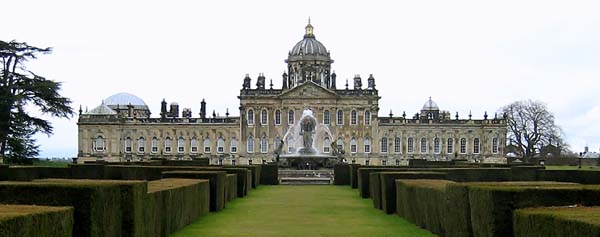 Well, there are so many reasons it's hard to know where to start.
For one thing, Castle Howard sits in a designated area of
outstanding natural beauty and offers the visitor extensive
grounds that are second to none. In 1732 John Atkyns, clearly
delighted by what he found there, wrote: "If our first
parents, after being turned out of the Garden of Eden, had been
immediately placed upon this spot of ground, they would have
concluded that they had only exchanged one Paradise for
another."
Well, there are so many reasons it's hard to know where to start.
For one thing, Castle Howard sits in a designated area of
outstanding natural beauty and offers the visitor extensive
grounds that are second to none. In 1732 John Atkyns, clearly
delighted by what he found there, wrote: "If our first
parents, after being turned out of the Garden of Eden, had been
immediately placed upon this spot of ground, they would have
concluded that they had only exchanged one Paradise for
another."
Mr Atkyns may have overstated slightly, but his enthusiasm is
understandable. Following in his footsteps nearly 300 years
later, I very much enjoyed my own tour of the gardens, temples,
follies and lakes that surround this wonderful building -- which
despite its name is an 18th-century palace and a lived-in family
home rather than a castle. An additional, unexpected pleasure was
provided by the free-ranging peacocks that followed me as I
explored Ray Wood.
I'll return to the delights of the grounds later. First let's
take a brief look at the history of the house, and sample a
taster of what it has to offer.
The Third Earl
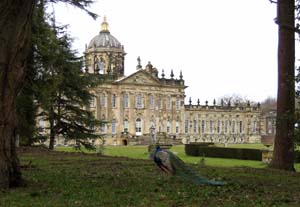 The
man behind the building of Castle Howard was Charles, the 3rd
Earl of Carlisle (1669-1738). He was a member of the famous
Kit-Cat Club, a group of wealthy individuals who were at the
centre of London's social life around 1700. A fellow member of
the club was the dramatist John Vanbrugh, and although Vanbrugh
had no architectural experience whatsoever, Charles chose him to
design and build the house that was to become his lasting
monument. The
man behind the building of Castle Howard was Charles, the 3rd
Earl of Carlisle (1669-1738). He was a member of the famous
Kit-Cat Club, a group of wealthy individuals who were at the
centre of London's social life around 1700. A fellow member of
the club was the dramatist John Vanbrugh, and although Vanbrugh
had no architectural experience whatsoever, Charles chose him to
design and build the house that was to become his lasting
monument.
It took more than a hundred years to complete Castle Howard, but
the bulk of the work was done between 1700 and 1710. The most
dramatic feature was the central dome, a bold structure that had
never been used to crown a private dwelling in England before. It
attracted a great deal of interest, and many of the 3rd Earl's
fashionable friends were more than a little envious of his new
home.
John Vanbrugh died in 1726, and the third Earl followed him
twelve years later. At that point the house was still unfinished,
and although the fourth Earl continued to work on it, when he
died in 1777 there was still much to do. Finally, with the
decoration of the Long Gallery by Tatham in 1811, the
construction of Castle Howard could be said to be completed,
although further improvements and additions such as the 7th
Earl's Monument continued to be made until about 1870.
The Great Fire of 1940
On the 9th November 1940, disaster struck. The southeast Wing of
Castle Howard caught fire, the blaze spread into the Great Hall,
and many rooms were destroyed, as was the central dome. If it
hadn't been for the determination of George Howard, who inherited
the house following the deaths of his two brothers in WWII, it is
unlikely there would be much left for the visitor to see
today.
However, under George Howard's guiding hand the dome was rebuilt
in 1962. As time and money allowed he continued to repair and
restore, and in 1981 the Garden Hall was also rebuilt.
In the year 2000 Castle Howard was 300 years old, and an
estimated ten million people had been to visit it since 1950.
Every year an additional 200,000 members of the public arrive to
swell that number, each visit being a testament to the popularity
of the 3rd Earl's great project.
A Tour of the House
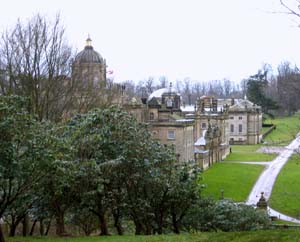 Visitors enter Castle
Howard via the West Wing, and are free to explore the rooms at
their own pace, although there are guides scattered here and
there who are more than happy to answer questions. Visitors enter Castle
Howard via the West Wing, and are free to explore the rooms at
their own pace, although there are guides scattered here and
there who are more than happy to answer questions.
The West Wing entrance leads directly into the Chapel, and an
aptly named Grand Staircase, built in the 1870s, lies ahead. Here
you'll find a marble altar from the Temple of the Oracle at
Delphi, which Nelson took from the French at Naples. Portraits of
the first six Earls of Carlisle hang on the walls, and at the top
of the Grand Staircase is a bust of the 7th Earl.
In 1850 Queen Victoria visited the house. The bed in which she
slept still stands in the Dressing-Room, surrounded by paintings
of landscapes by the Venetian artist Marco Ricci, all of them
produced between 1709 and 1710.
When the 4th Earl toured Italy in 1738, he brought back many of
the statues, busts, and urns that caught his eye. These treasures
are now displayed in the Antique Passage. There are in fact two
such passages -- twin corridors that run the length of the house
from east to west. Their draught-free nature was clearly a matter
of some pride to John Vanbrugh, for in the winter of 1713 he
wrote: "Though we have now had as bitter storms as rain and
wind can well compose, every room in the house is like an oven,
and in corridors 200 feet long there is not air enough in motion
to stir the flame of a candle."
The letters the 4th Earl wrote during the collection of his
various antiques (he had a keen eye for a bargain and was not
above haggling over prices) tell an interesting story. Snippets
of detail such as the rivalry between the Earl's agents and his
worries about the possibility of pirates attacking the ships and
stealing their cargo make for fascinating reading and give an
insight into the daily life and the nature of the man.
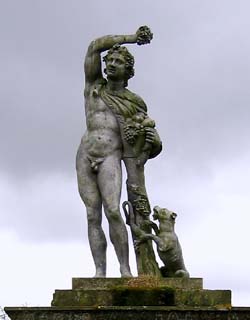 The
Antique Passage leads to the Great Hall, which lies directly
beneath Castle Howard's spectacular dome, some seventy feet above
the visitor's head. There are four massive and highly-decorated
columns here which were carved by Samuel Carpenter in 1705 at a
cost of £84, and also some fine painted decoration executed
by Giovanni Pellegrini between 1709 and 1712. The
Antique Passage leads to the Great Hall, which lies directly
beneath Castle Howard's spectacular dome, some seventy feet above
the visitor's head. There are four massive and highly-decorated
columns here which were carved by Samuel Carpenter in 1705 at a
cost of £84, and also some fine painted decoration executed
by Giovanni Pellegrini between 1709 and 1712.
Like most young men of their class, the 3rd, 4th and 5th Earls
all visited Europe on the customary Grand Tour, collecting
objects of art as they did so. As a result, Castle Howard once
housed a very large collection of paintings, including work by
Pannini, Zuccarelli and Canaletto. Some of these pictures were
sold: others were destroyed in the fire of 1940. However, it is
still possible to see work by Hans Holbein, Gainsborough, George
Stubbs and many others as you wander from room to room.
Several of the objects to be found in the Chapel Lobby could be
classed as curiosities. There is, for example, a 19th century
pedestal bowl made of Siena marble. On its three legs one can see
entwined serpents, pine cones and claws, and it has been
suggested that this object was in fact used as a bleeding-bowl.
After being bled, perhaps the unfortunate patients were allowed
to take a drink from one of a pair of glass pigs that function as
spirit flasks, the contents pouring out through their hollow,
glassy snouts. Here you can also find a decorated wheelbarrow,
which was presented to the 7th Earl when he was Lord Lieutenant
of Ireland, and a commemorative spade given to him in 1846 when
the North Western Railway was opened at Settle.
There are several other rooms and many more treasures to be seen
inside the house, but let's finish this brief tour with a closer
look at some of the external features to be enjoyed if the
weather is kind.
The Rose Gardens and the Fountains
This walled enclosure was, in the early years of the 18th
century, a kitchen garden, but it's now primarily devoted to
roses. There are in fact three rose gardens here. In 1975, Lady
Cecilia's Garden was established, dedicated to the memory of
George Howard's much-loved wife. The roses here are traditional
varieties, but the Sundial and Venus Gardens, which were laid out
later, are just as impressive, and in summer they fill the air
with the scent of over 2,000 modern roses of various types.
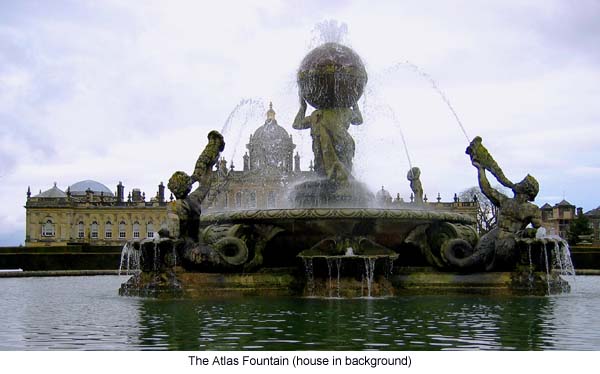 In the 1850s the 7th Earl commissioned two fountains: the Atlas
Fountain (carved from Portland stone by John Thomas) and the
Prince of Wales Fountain in the South Lake. The initial estimate
of the cost of these fountains was £2,000 -- but the final
figure came to £10,000, which at that time was
astonishingly costly. Both fountains are gravity-fed from a
reservoir in Ray Woods, some seventy feet above the South
Parterre.
In the 1850s the 7th Earl commissioned two fountains: the Atlas
Fountain (carved from Portland stone by John Thomas) and the
Prince of Wales Fountain in the South Lake. The initial estimate
of the cost of these fountains was £2,000 -- but the final
figure came to £10,000, which at that time was
astonishingly costly. Both fountains are gravity-fed from a
reservoir in Ray Woods, some seventy feet above the South
Parterre.
The Temple of the Four Winds, inspired by Palladio's Villa
Rotonda in Vicenza, was completed in 1738. It was originally
known as The Temple of Diana and was in danger of collapse until
George Howard restored it in 1955.
The Mausoleum, which stands nearly a mile away from the house,
was constructed after the 3rd Earl wrote in his will: "I do
design to build a burial place near my seat of Castle Howard,
where I desire to be layed..." Building began in
1729, but for various reasons the 3rd Earl's last resting place
was not completed until several years after his death in 1738. He
was first buried in the local parish church, but eventually was
interred in the Mausoleum as he had requested. The Mausoleum
remains the burial place of the Howard family to this
day.
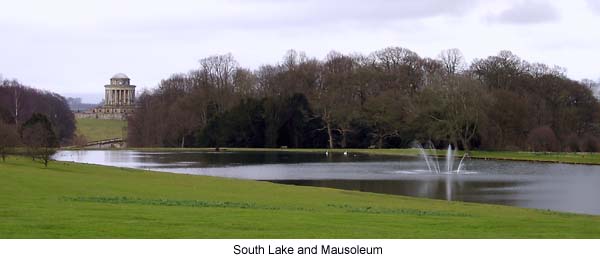
More Information:
We regret that we no longer have the resources to maintain up-to-date links and/or hours and pricing details for the various sites and attractions listed on this website. For more information about the location(s) listed above, please use your favorite search engine or visit Wikipedia.
John Ravenscroft is a teacher-turned-writer who lives in Lincolnshire, England. He spends much of his time struggling to write fiction and co-editing Cadenza Magazine. His short stories have won prizes in various literary competitions and been published in numerous magazines, and his work has also been broadcast on the BBC. Visit his website at http://www.johnravenscroft.co.uk.
Article © 2006 John Ravenscroft; photos © Astra Ravenscroft
|
